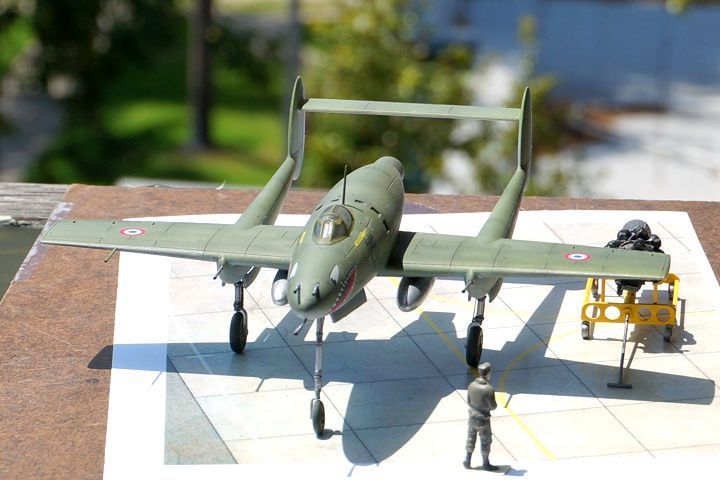Father Ennis - the silvering in the decals wasn't the usual type. The decals had a coat of Future under them and were OK... until the Solvaset hit them. I pushed them down and let them dry and after a few days, the silvering was gone or greatly reduced. I have a problem with canopy framing, regardless of the method used.
Here's the ki-98 with the drop tanks:

With the Nene engine on a workstand, and "Henri" the photographer:



The workstand is a heavily modified stand from the MAC 1/72 JB-2 Loon. The Nene engine is a neat little resin kit from Aries and the PE bits are very soft and easy to work with.

Thanks for all the comments!
Backstory:
In 1945, The Mansyū (Manchurian Aeroplane Manufacturing Company Ltd.) was ready for the test-flight of their advanced fighter, the Ki-98. The imminent defeat of Japan and the threat of both the Soviet Army and reprisals from the various Chinese factions caused the Japanese and their Manchukuo allies to order the destruction of the prototype and its tooling and plans. This order never made it to the plant and the lead designer, who had received his education in France, decided to use the Ki-98 as a "resume", with the hopes of continuing his career under the auspices of one of the victors (but not the Soviets or Chinese).
He and several trusted junior engineers crated the prototype (minus the engine) , tooling and plans into a train packed with injured civilians - the crates were marked as humanitarian supplies.
The train was originally destined for Seoul, Korea but the cars with the Ki-98 and its engineers ended up rerouted through China and into Laos.
Immediately after the war, the plane was offered to the returning French forces, who quickly confiscated it and placed it in storage. The French were facing a mounting anti-colonial resistance in Vietnam and had no time for new aircraft construction.
The war of independence was short-lived; the US and the UK (who were by now quite fed up with De Gaulle) refused to support the French and actively blocked any French attempts to resupply its forces. The French were forced from Vietnam into their remaining colonies in Laos and Cambodia.
Still needing an ally against the Communists, the French, US and UK entered an agreement; in exchange for their losses in Vietnam, the French would receive tanks and fuel from the US and license to build the Rolls Royce Nene engine. This would allow them to defend their colonies.
The new agreement was soon put to the test, as the Communist Chinese forces, after their quick defeat of Kuomintang in 1947, expanded and "liberated" parts of Laos from the French and were threatening both Thailand, Vietnam and the last major French colony, Cambodia. A war weary US and Great Britain were not willing to go to war against the Chinese, but they were willing to support the French defense of their colonies.
The old Spitfires and repurposed Japanese planes in the French colonial air force were just able to slow the Chinese advances. The French decided that it would be quicker to assemble new aircraft in Cambodia than have them shipped to the area from France. In 1947, they opened a factory in Phnom Penh and the nearly complete Ki-98 was test-flown with a piston engine. Performance was hampered by the old engine used in the Ki-98. The plans were handed over to Arsenal de l'Aéronautique, who - with little modifications to the airframe - were able to install a license built Nene engine into the now renamed Arsenal VG-98.
The original landing gear was designed for a large prop; there were plans to shorten the gear but initial flights of the prototype showed that the tall gear was an asset when taking off from front-line airstrips, since it all but eliminated FOD to the engine.
Even though less than 20 planes were built, the VG-98's 37mm cannon and four 20mm canons were highly effective against the Soviet supplied T-34 tanks used by the Chinese, as well as trains and other troop transports.